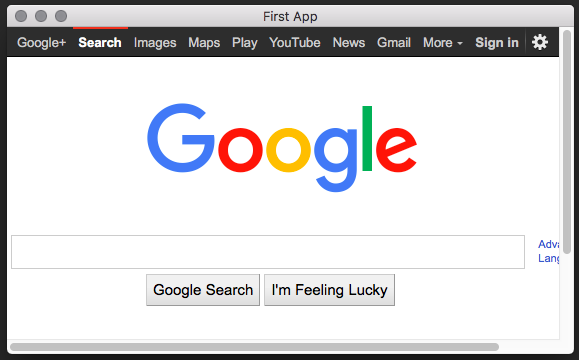WebView#
The Web View widget is used for displaying an embedded browser window within an application.
Both sites served by a web server and local content can be displayed. Due to security restrictions in the macOS backend WKWebView, local content on macOS can only be loaded from a single directory, relative to the base URL, and not from an absolute “file://” URL. As a workaround, it is possible to use a lightweight webserver instead.

Usage#
import toga
web = toga.WebView(url='https://google.com')
Debugging#
If you need to debug the HTML, JavaScript or CSS content of a view, you may want to use the “inspect element” feature of the WebView. This is not be turned on by default on some platforms. To enable WebView debugging:
macOS
Run the following at the terminal:
$ defaults write com.example.appname WebKitDeveloperExtras -bool true
substituting com.example.appname with the bundle ID for your app.
Reference#
- class toga.widgets.webview.WebView(id=None, style=None, factory=None, url=None, user_agent=None, on_key_down=None, on_webview_load=None)#
A widget to display and open html content.
- Parameters:
id (
str) – An identifier for this widget.style (
Style) – An optional style object. If no style is provided then a new one will be created for the widget.url (
str) – The URL to start with.user_agent (
str) – The user agent for the web view.on_key_down (
callable) – The callback method for when a key is pressed within the web viewon_webview_load (
callable) – The callback method for when the webview loads (or reloads).
- MIN_HEIGHT = 100#
- MIN_WIDTH = 100#
- add(*children)#
Add the provided widgets as children of this widget.
If a node already has a different parent, it will be moved over. This does nothing if a node already is a child of this node.
Raises
ValueErrorif this widget cannot have children.- Parameters:
children – The widgets to add as children of this widget.
- property app#
The App to which this widget belongs.
When setting the app for a widget, all children of this widget will be recursively assigned to the same app.
Raises
ValueErrorif the widget is already associated with another app.
- property can_have_children#
Determine if the node can have children.
This does not resolve whether there actually are any children; it only confirms whether children are theoretically allowed.
- property children#
The children of this node. This always returns a list, even if the node is a leaf and cannot have children.
- Returns:
A list of the children for this widget.
- property dom#
The current DOM.
- Returns:
The current DOM
- Return type:
str
- property enabled#
Is the widget currently enabled? i.e., can the user interact with the widget?
- async evaluate_javascript(javascript)#
Evaluate a JavaScript expression, returning the result.
This is an asynchronous operation. The method will complete when the return value is available.
- Parameters:
javascript (
str) – The javascript expression to evaluate.
- focus()#
Set this widget to have the current input focus.
- property id#
The node identifier. This id can be used to target styling directives.
- insert(index, child)#
Insert a widget as a child of this widget.
If the node already has a parent, ownership of the widget will be transferred.
Raises
ValueErrorif this node cannot have children.- Parameters:
index – The position in the list of children where the new widget should be added.
child – The child to insert as a child of this node.
- invoke_javascript(javascript)#
Invoke a JavaScript expression.
The result (if any) of the javascript is ignored.
No guarantee is provided that the javascript has completed execution when `invoke()` returns
- Parameters:
javascript (
str) – The javascript expression to evaluate.
- property on_key_down#
The handler to invoke when the button is pressed.
- Returns:
The function that is called on button press.
- Return type:
callable
- property on_webview_load#
The handler to invoke when the webview finishes loading.
- Returns:
The function that is called when the webview finishes loading.
- Return type:
callable
- property parent#
The parent of this node.
- Returns:
The parent of this node. Returns None if this node is the root node.
- refresh()#
Refresh the layout and appearance of the tree this node is contained in.
- refresh_sublayouts()#
- remove(*children)#
Remove the provided widgets as children of this node.
This does nothing if a given node is not a child of this node.
Raises
ValueErrorif this node is a leaf, and cannot have children.- Parameters:
children – The child nodes to remove.
- property root#
The root of the tree containing this node.
- Returns:
The root node. Returns self if this node is the root node.
- set_content(root_url, content)#
Set the content of the web view.
- Parameters:
root_url (
str) – The URLcontent (
str) – The new content
- property tab_index#
The position of the widget in the focus chain for the window.
- property url#
The current URL.
- Returns:
The current URL
- Return type:
str
- property user_agent#
The user agent for the web view as a
str.- Returns:
The user agent
- Return type:
str
- property window#
The window to which this widget belongs.
When setting the window for a widget, all children of this widget will be recursively assigned to the same window.
